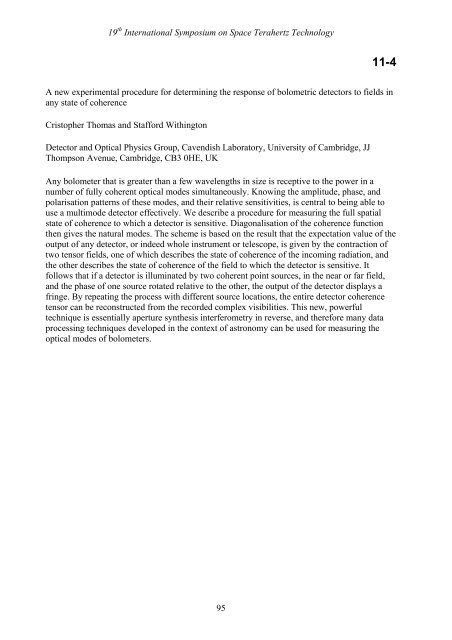Program and Abstract Book - SRON
Program and Abstract Book - SRON
Program and Abstract Book - SRON
Create successful ePaper yourself
Turn your PDF publications into a flip-book with our unique Google optimized e-Paper software.
19 th International Symposium on Space Terahertz Technology<br />
11-4<br />
A new experimental procedure for determining the response of bolometric detectors to fields in<br />
any state of coherence<br />
Cristopher Thomas <strong>and</strong> Stafford Withington<br />
Detector <strong>and</strong> Optical Physics Group, Cavendish Laboratory, University of Cambridge, JJ<br />
Thompson Avenue, Cambridge, CB3 0HE, UK<br />
Any bolometer that is greater than a few wavelengths in size is receptive to the power in a<br />
number of fully coherent optical modes simultaneously. Knowing the amplitude, phase, <strong>and</strong><br />
polarisation patterns of these modes, <strong>and</strong> their relative sensitivities, is central to being able to<br />
use a multimode detector effectively. We describe a procedure for measuring the full spatial<br />
state of coherence to which a detector is sensitive. Diagonalisation of the coherence function<br />
then gives the natural modes. The scheme is based on the result that the expectation value of the<br />
output of any detector, or indeed whole instrument or telescope, is given by the contraction of<br />
two tensor fields, one of which describes the state of coherence of the incoming radiation, <strong>and</strong><br />
the other describes the state of coherence of the field to which the detector is sensitive. It<br />
follows that if a detector is illuminated by two coherent point sources, in the near or far field,<br />
<strong>and</strong> the phase of one source rotated relative to the other, the output of the detector displays a<br />
fringe. By repeating the process with different source locations, the entire detector coherence<br />
tensor can be reconstructed from the recorded complex visibilities. This new, powerful<br />
technique is essentially aperture synthesis interferometry in reverse, <strong>and</strong> therefore many data<br />
processing techniques developed in the context of astronomy can be used for measuring the<br />
optical modes of bolometers.<br />
95
















